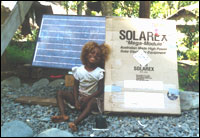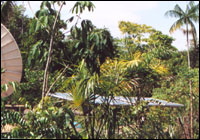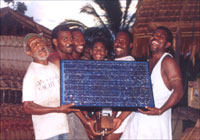The groaning has largely subsided over last month’s World Summit on Sustainable Development in Johannesburg, South Africa, but one of the biggest disappointments of the event still deserves scrutiny: the failure to create a strategy to disseminate renewable energy throughout the developing world. “The Johannesburg summit’s plan for renewable energy has two fundamental flaws — there is no plan and nothing to implement,” says Cowan Coventry, chief executive of the Intermediate Technology Development Group (ITDG), a U.K.-based nonprofit. “The U.S. and the OPEC states scuppered the chance to switch on lights, refrigerators, water pumps, and other essential devices in the poorest parts of the world.”

A bright idea.
Photo: SELF.
As it happens, there wouldn’t even have been a chance to scupper if the OPEC countries and the U.S. had had their way: Heavy lobbying on their part at pre-conference planning sessions had completely wiped energy issues from the summit agenda until, at the last minute, renewables advocates from the U.K., Brazil, and South Africa found a way to sneak them back in. But all efforts during the conference to develop specific targets or allocate reasonable funding for renewable energy projects were trounced by the U.S. -OPEC juggernaut.
This does not, of course, come as much of a surprise. Why would nations that are reluctant to encourage renewable energy at home champion it abroad? And why should public aid programs prioritize electricity projects in the face of disease, drought, famine, civil liberties abuses, civil revolt, and other escalating scourges of the developing world? And given the climate of global recession — direct foreign investment plummeted 60 percent in the last year — why would anyone want to launch ambitious technology projects in risky, rural, undeveloped markets?
There are, you might say, billions of reasons. Nearly a third of the world’s population — roughly 2 billion people — currently lives in rural areas without access to an electricity grid. The United Nations Environment Programme predicts that global energy demand will double in the next 25 years, largely due to increased energy use in developing nations. The implications are staggering, as much for the damage that would result from doubling the side effects of our current energy system as for the colossal economic opportunity inherent in the untapped demand. Now is the time to encourage a budding renewables market in the developing world — before old-school utilities lay down their lines.

Bringing straw for fuel to a Ghana
market.
Photo: NREL.
Capitalism, after all, dictates that demand creates supply. “For better or worse — whether by expanding grid systems and building power plants, increasing the use of the diesel generators and kerosene which are typically used in rural markets today, or installing on-site renewable energy systems village by village — that demand will eventually be met,” says Neville Williams, chair of the Solar Electric Light Company, aka SELCO, one of the first companies to sell renewable energy systems in rural, developing markets. “Clearly, it is of critical global importance that the demand is met in a sustainable way.”
It’s also critically important to consider, up front, the boatload of woes that will be ushered in to developing countries along with electricity. Electricity is the gateway to global capitalism and the lifeline of consumer culture — where it goes, televisions, computers, and satellite Internet connections will soon follow. But the haunting prospect of “Good Morning America,” MTV, and “Martha Stewart Living” streaming to billions of new viewers seems trivial when you consider that access to electricity will help correct the most basic inequities in the developing world. Without refrigeration, there’s little access to medicine; without electric pumps for irrigation, there’s limited farming and food; without light bulbs, there’s no safe, pollution-free lighting; and without stovetops, there’s no alternative to cooking fires, which generate indoor pollution and kill an estimated 2.5 million people each year, according to ITDG.
Photovoltaic Shop
While the environmental arguments for choosing renewable energy over fossil fuels in the developing world are convincing, the economic arguments are even more so. It is cheaper to install wireless photovoltaic systems in remote communities than to run new transmission lines from a central utility to villages that are scattered far and wide, often in hard-to-reach areas. And while roughly half of the developing world market is shelling out $5 to $10 per month on fuel for kerosene lamps and mini diesel generators, solar, wind, and geothermal systems would require comparatively minimal maintenance costs and zero refueling costs (with the exception, in the case of solar, of changing the battery roughly once a decade).
In industrialized nations, utility-based electricity is already incredibly cheap and accessible. But that’s not the case in developing nations, which makes them, in many ways, a better market for renewable energy. According to Strategies Unlimited, a California-based market research firm, roughly 40 percent ($1.2 billion) of the $3.5 billion solar business in 2002 came from rural markets. Yet the growth in demand in rural markets — 15 percent per year for the past three years — is less than half of that in industrialized markets — more than 30 percent per year during the same period.
The primary reason for the disparity, aside from the fact that the developing world is simply poorer, is that the effort to establish an effective business model for grassroots rural markets has only just begun. How do you reach consumers in communities with no stores, or no existing infrastructure, or who have never heard of credit? In the last several years, three for-profit companies have begun leading the way: SELCO, Shell Solar, and Soluz. “We are the trailblazers — the first to try to organize local markets in multiple countries, and the first to develop business models for deeper market penetration — to reach consumers who can’t afford to buy the systems outright,” says Richard Hansen, president of Soluz, a rural electric development company that has sold or rented more than 6,000 solar systems to households in the Dominican Republic and Honduras.

Amazon.sun: a solar project in the
rainforest.
Photo: SELF.
Three different market models have emerged so far in the developing world: “Cash markets” are comprised of mom-and-pop stores in major cities in developing nations that sell small-scale PV systems (20 to 100 watts), which villagers buy for $450 to $600. Although these stores are thriving, they reach only those who can lay down that much money at once — a tiny portion of rural consumers. To appeal to a much wider market, both SELCO and Shell Solar are focusing their efforts on micro-financing programs, which allow customers to buy PV systems over two to five years by paying $15 to $50 dollars per month. For an even wider reach, Soluz has developed a “fee-for-service” (or rental) model that, like a utility, does not sell the power source, but rather the electricity it generates, usually for between $10 and $20 per month. Soluz has not yet reached profitability with this model, but Hansen says he expects it will by the end of 2003. He’s committed to developing an alternative to the micro-financing model because much of the population in the developing world has no access to the local banks or lending institutions that help establish such financing programs.
So far, the microfinancing programs have proven to have the most profit potential. SELCO, for instance, has already sold 17,000 systems in India, Vietnam, and Sri Lanka using this model, and expect to bring in $4 million in revenues this year. “It’s not a whole lot in the grand scheme of things, but it’s enough to make us profitable for the first year ever,” says Williams, “And that is proof of principle that rural markets can work.”
Williams developed the micro-financing model through the Solar Electric Light Fund, a Washington, D.C.,-based nonprofit he started that helps families finance PV systems for their homes. SELF and other nonprofits have provided a critical testing ground for renewable energy dissemination strategies that can be adopted by for-profit companies. Under the direction of Bob Freeling, SELF is now developing new models that could eventually spawn other for-profit ventures. In South Africa, he developed a successful program to spread solar energy, computers, and communications technology all at once; in Brazil, he’s working to employ solar power as a way to develop micro-enterprises that will bring more earnings to rural communities.
Getting Grounded
Needless to say, the actual dollar amounts earned so far from local markets are still peanuts compared to the bulk purchases for donated systems funded by some governments and by heavy subsidies from organizations such as the World Bank, the Global Environmental Facility, the United Nations Environment Programme, and monies raised by nonprofits. But while such programs are important, they are not a long-term solution to providing electricity for 2 billion people. “In the long-term, healthy local markets will be the most effective mechanism [for spreading renewable technology in the developing world], but there has to be a public-private partnership to get the ball rolling,” says Williams.

They’ve got the power: a PV panel
in the Solomon Islands.
Photo: SELF.
Donated and subsidized programs have the disadvantage of not establishing the kind of local infrastructure that a market begets, such as technical expertise and services to replace existing technology and teach consumers how to maintain their new systems. Often referred to as “dump and run” programs, giveaway programs are more likely to result in misused or unused technology once the aid group leaves, whereas local markets establish both an infrastructure and a sense of ownership. (In some extreme cases, villagers who have not been educated in the value of photovoltaic systems have reportedly used solar panels to make jewelry and tools.)
Whereas these top-down programs have been relatively well-funded to date, grassroots markets have been operating largely without producer subsidies. Public funds for solar projects in the developing world have been significant — the World Bank’s solar spending program has totaled more than $1 billion in the last decade — but very little of that money is going to the entrepreneurs. “The trailblazing companies aren’t seeing any of the public funds so far. The money flows to consultants, government agencies, nonprofits and investment funds, and even to consumer subsidies, but we also need an enabling framework [for the market pioneers] to help us absorb the risk and cost of innovation,” Soluz’s Hansen says.
But again, the concept of a viable market for renewables in the developing world is only just now becoming a reality. Soluz, SELCO, and Shell Solar have been around for less than a decade, and their progress is only now starting to turn heads: “It’s too early in the process to say which models work yet, but there’s progress — these intrepidors are gaining a lot of credibility,” says Dana Younger, coordinator of the Global Environment Facility Environment Projects Unit, which manages a $20 million budget for solar investment. “We’ll work with them to refine the business models and create incentives to encourage their development.”
Younger is now working on a project in the Philippines that offers a $100 subsidy to solar distributors for every system they sell. “We’re just scratching the surface,” says Younger. “Right now, the marketers consist of guys on bicycles and mopeds who cruise dirt roads from village to village, sometimes hours apart, in search of potential consumers. They’re like the Tennessee Valley Authority guys in the 1930s traveling from bog to hollow in rural Appalachia to get everyone online.” Considering that today the TVA supplies the energy needs of more than 8 million customers, the analogy augurs well for renewable energy in the developing world.

